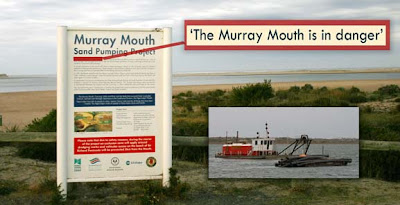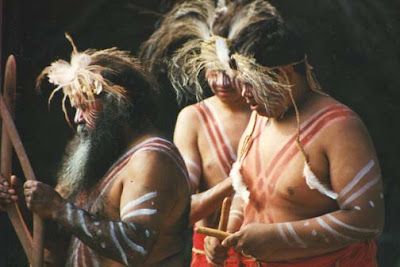
At Raukkan the sands are strewn with old leather heels, presumably from the boots of Ngarrindjeri wool-washers. Along the lake's rim, five thousand year old stone circles of Ngarrindjeri fish-farming are being scattered by grazing cattle. “What pretty rock formations,” said a local, ignorant of Ngarrindjeri heritage. Grimmer is the exposure of remains from Ngarrindjeri burial grounds around the lakes. The cultural and economic impact on Ngarrindjeri communities is profoundly distressing.
In the 12 years I've lived at Narrung, the church has closed, then the general store and petrol pump, and then the school. It's likely the police station will close soon, and also the ferry too, adding 70 odd kms on the journey to the nearest major centre. Loss of viable habitat, loss of livelihoods, loss of relationships has impacted severely on this community. Instead of the gentle sound of swans of an evening, I hear the mechanical drone of pumps: artificial life support for Lake Albert.
"This peninsula must have been a Paradise for the Aborigines of long ago," observed E. Leta Padman, "with all the variety of food so readily available." "Those who are here today can never realize the condition of this country in the early days. Kangaroos abounded in the thousands," reminisced a Mr Hacket. The "numerous tortoises" Padman describes around 1987 "trundling across the roads and paddocks from the water to higher ground," are now a rare sight and even then they are likely to be encrusted with killer marine worms. "Today the travellers through Narrung can feast their eyes on a great variety of birds," wrote Padman. [The Story of Narrung: the place of large she-oaks, c1987, p24] No more. There has been an 85% reduction in the number of seasonal migratory birds, said Dr Arlene Buchanan of the Australian Conservation Foundation recently.
“Over ten years ago ... a group of us Aboriginal people took the people right through the old waterways and showed them the courses where the water came ... and they suggested to us that they didn't have any time to listen to old Aboriginal stories and that really crushed us way back then. And ever since then, it's been receding ever since,” observed Ngarrindjeri Rupulli George Trevorrow.
"Irreversible ecological collapse,"says the Australian Conservation Foundation, is the "only option" to not bringing flows down the river. Without urgently needed flows it will be "a toxic waste dump." [Josie Taylor. "Govt says the Murray's Lower Lakes can't be saved."06/08/2008. http://www.abc.net.au/lateline/content/2008/s2326382.htm]
The state of the Lower Lakes and Coorong is "an act of monumental environmental vandalism without precedent in Australian history," observed Greg Hunt, SA's opposition Environment spokesperson. He pointed out that Australia is perilously close to becoming "only the second Government in the world to have presided over the destruction of a Ramsar listed wetland." The first was led by Iraq's Sadam Hussein.
Upstream Dr Jennifer Maharosy warns of “a potential economic and social catastrophe” if measures are not implemented to “keep the river full of water.” Maharosy claims that if "a permanent weir" were built "just upstream of the lakes at Wellington,” there could be "water savings in the order of 750,000 megalitres a year.” She advocates that barrages be opened, allowing the Lower Lakes and Coorong to be flooded with sea-water. [“Barrages Block Sense.” http://www.jennifermarohasy.com/articles155.html]
But local expert Dr Muller suggests that tidal flow through the mouth would not have enough energy to flush the lakes, "leaving vast areas of acidified wasteland." She also warns that "rapid conversion to salinities of seawater" might result in the contamination of "some 100,000 ha," making the region "uninhabitable" and "requiring the permanent retiring of productive land, both irrigated and dryland, and possible evacuation of lakeside communities."
According to a lower lakes irrigator and the Australian Conservation Council a 10-15% reduction of all water allocations in the Murray Darling Basin would let enough water flow down the River for both consumptive needs and restorative environmental flows.
It has been hard to write this without feeling overwhelmed by distress. In 2008/9 are we writing arequiem for the Coorong and the lower lakes?
The recent winter rains have been an answer to prayer and the drought-grey sands have sprung alive with green. Whether the lower lakes and Coorong survive, and the Murray-Darling too, is dependent not just on water flows, but on people behaving better towards Mother Earth and Her waters than they have in the past two centuries.
A Ngarrindjrei elder guided our craft up the Coorong. Although it was deep night, we could make out the curves of the tea-tree and coastal wattle on the dunes. An oyster-catcher called from the south, a shrill “Peep-peep. Peep-peep.” Another joined in: “Per-peep, per-peep.” “Come here! Come here! This way,” it seemed to say. Above us, the veil of cloud thinned. We caught a glimpse of the moon and a handful of stars, and as if waiting for us, the black and white form of our haunting feathered songster. The water around us sparkled. “Put your hand in,” Paul directed. We did and were surprised with an electric shock. How? Why? In and out, we playfully dipped our hands and every time got zapped. This stretch of the water looked the same as anywhere else, and yet it held, 'scuse the pun, a shocking secret. Further on, Paul told us to jump out of the boat. We rolled up our trouser-legs and hoisted ourselves overboard. Splash! Black water came alive with sparks of light: another magical surprise. “Phosphorescence,” our Ngarrindjeri guide explained.
I don't want experiences like this to be lost to our children. Let's put aside our private interests and invest in the Life and Health of the River.
In the words of Storm Boy's author Colin Thiele:
“It is good that some people have known the Coorong and loved it for what it once was -for its untouched beauty, its light, its elemental naturalness,its peace and isolation,for it may soon be destroyed, is already in danger of being destroyed – trampled to death by the modern sacred cows of tourism, development and recreation. [excerpt from“The Coorong”]
If Australia allows this region to die, the consequences, the shame of it, will hang around this nation's neck like a dead albatross. But better, much better is to revitalize the Swan the Ngarrindjera know in the form of the Lower Lakes and Kurangk; so Swan can sing us all to thrive.
"May our Spirits find rest and peace within our Lands and Waters." [Kungun Narrindjeri Miminar Yunnan]

















































